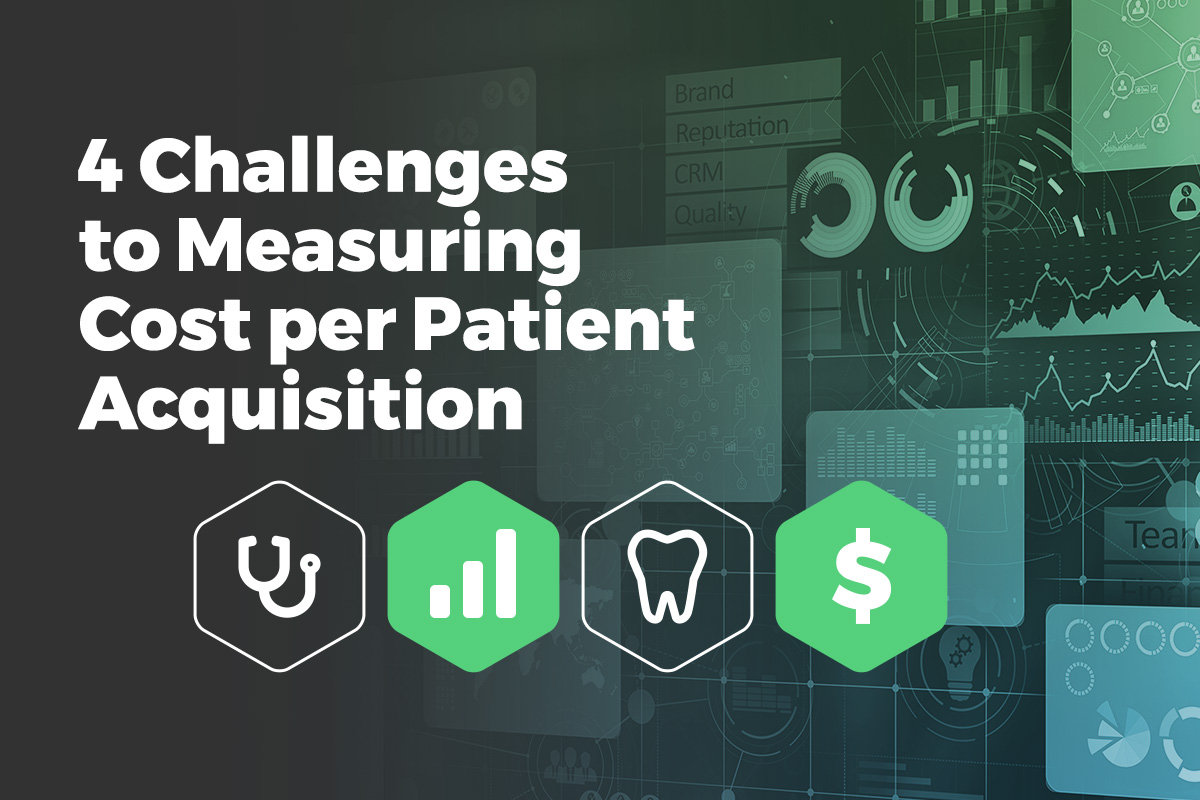As marketers, we strive to report on the metrics that matter to our clients. Regardless of industry, we can all agree that there’s one performance metric that shines above all others, and that is the cost per acquisition. In the healthcare and dental space, data on patient acquisition costs is hard to come by.
In an ideal world, you should be able to control your marketing levers to produce the results you need. If you know how much, on average, it costs you to bring in a new patient; then you know much more than most businesses. With this information, you have the control to assess your marketing without having to decipher other less-telling metrics.
By knowing your acquisition costs, you can add budget with a sound expectation on what it will return, and you can better monitor performance. If you see a spike in acquisition costs that have long been stable, you know something is not working optimally.
If you’ve worked with marketing agencies to generate new patients for your practice before then, you must know how difficult it can be to get these numbers. The campaigns are running, and phone calls are coming in, but would those patients be calling you anyway? Is it the marketing that’s influencing your appointments booked?
We know how confusing it can be to assess marketing performance and that confusion can often lead to frustration without all of the facts. We want to help explain the challenges to finding your actual cost per new patient and how you can combat those challenges to get closer to a valid measurement.
The four most significant challenges we've faced when building dashboards to measure patient acquisition costs...
The challenges we’ve faced with clients in the healthcare and dental spaces are Patient Management Systems, Marketing Software, Communication and Transparency, and Accurate Data. If you have all four of these pieces working together, then you’re in a good place. Let me explain what happens when these pieces aren’t working together.
Patient Management System (PMS)
Your Patient or Practice Management Software (PMS) is your central hub for managing patients, but it is vital in determining acquisition costs. Is your software easy to use? Does it integrate with other marketing software? Does it store marketing data from patients unrelated to their diagnostic and appointment details?
Patient management systems that weren’t built for the modern-day require practices to utilize multiple pieces of software that, most of the time, do not integrate with the PMS making it challenging to centralize data.
If your PMS is not 100% up to par, that’s okay; you can get by as long as the ‘referral’ notes on each patient are accurate. It’s not helpful to have a patient in your system as a referral from “Google” if they came to you from your “Google My Business page.” Did the patient come from an organic Google listing or a paid Google ad? These are very different sources from Google. What’s even worse? When 80% of your referral data is labeled “None / Not Applicable.” Just “Google” is better than that.
Unless you’re asking each patient to be very specific on where they came from (You probably don’t want to do this), referral data is nearly impossible to correct. The best way to ensure the information is correct is to have your phone call tracking and your forms push all data into the PMS.
Marketing Softwares
Since most PMS are not as equipped as some of today’s best CRMs, like SalesForce, practices need to utilize additional marketing software. Typically this will be call tracking, online booking or virtual consultation, and email marketing tools.
With that said, if your PMS cannot track calls, allow people to book online via your website, and doesn’t have marketing tools to send email campaigns to your patients and prospects, you are at a higher risk of not being able to track your acquisition costs. The more software that data has to jump through, the worse.
Another thing to note is that marketing software is not the same, even if they do the same thing. Different call tracking tools and answering services track calls differently. And yes, some are better than others! This doesn’t affect overall acquisition costs, but it does make it more or less difficult to determine your patient acquisition costs across multiple sources.
These issues are easy to alleviate if you work with an experienced marketing team that can help you upgrade your software. We have the most problems when practices don’t want to switch up their software as they are more comfortable with their current processes. We will still help find a manageable solution.
Full Transparency & Communication
Practices need to have full transparency with their agency or marketing department on what tools and services they are paying for as it relates to marketing. To get your acquisition costs, you have to divide your marketing costs for the reporting period by the number of new patients. If you’re paying for software you’re using and have not informed your marketing team of that tool, your acquisition costs will be lower than the truth.
Be sure that your marketing team has a list of all the fees you pay each month for marketing. Your PMS is not a marketing cost; it’s an operational cost.
Accurate & Clean Data
You can still get close to a true acquisition cost if your PMS and marketing software isn’t optimal; however, it requires a more manual approach. If your PMS cannot collect and store the data coming from your other marketing software, your marketing team will need to manually extract data from the platforms and merge it to get a more holistic picture. Though this is doable, it requires very clean and accurate data.
We’ve experienced issues where the PMS is not gated, allowing all users to access everything within the system. This is not compliant with HIPAA and means that someone with clearance will need to extract lists and provide them to the marketing department. We think we all know how messy it can get sending lists back and forth continuously.
Suppose your marketing team is manually reviewing patient lists for your reporting. In that case, those lists must have 1) valid contact information, 2) consistent formatting of dates, phones, and IDs, and 3) as much other data that you want to be reported on, it can get pretty granular. You might want to report on location, procedure type, provider (Off the top of your head, are you able to get us this list now?). We have to be able to trust the data we are receiving. Any slight discrepancy can be a sign that this data isn’t accurate.
This also means that a member of the practice must take full responsibility to generate and provide these lists regularly. We often set up full acquisition dashboards just to never receive data from clients, and that’s not helping anyone.
In conclusion, your PMS has to store the data. If you’re facing challenges understanding how much it costs you to acquire a new patient for your practice, StrataBlue can help assess your software and recommend upgrading.
Suppose your software doesn’t sync like mentioned above, and you’re not interested in switching or you’re stuck in a contract. In that case, we can create a manual solution that merges data from all your software to better determine what sources brought your patients in and how much it cost you.
When you can present marketing metrics that resonate with your decision-makers, you’ll be in a much better position to make a case for budgets and strategies that will benefit your marketing team now and in the future.




